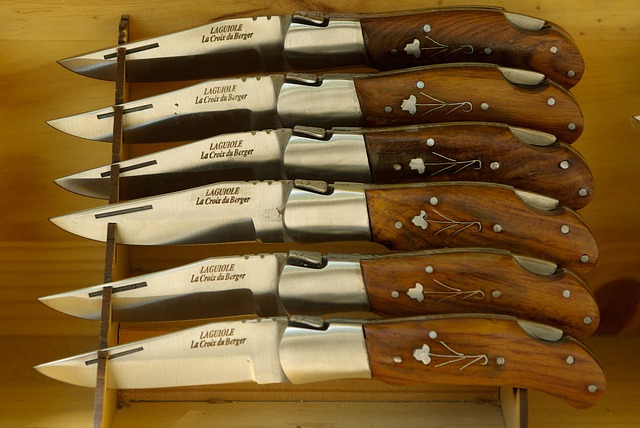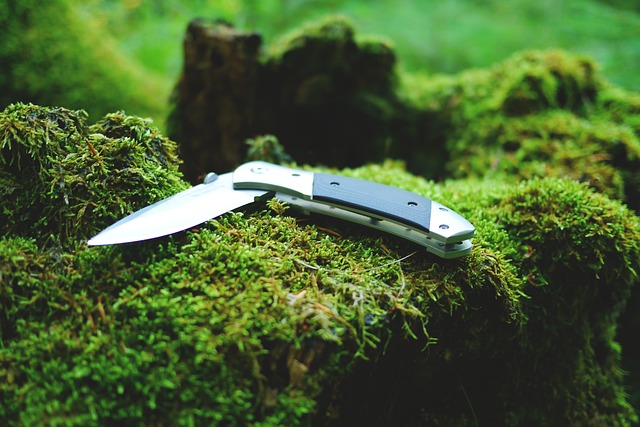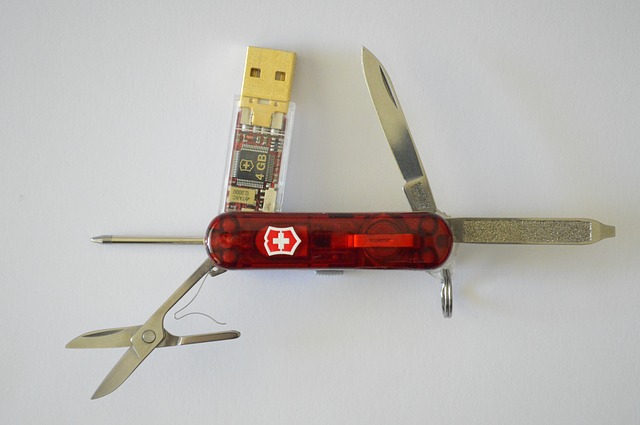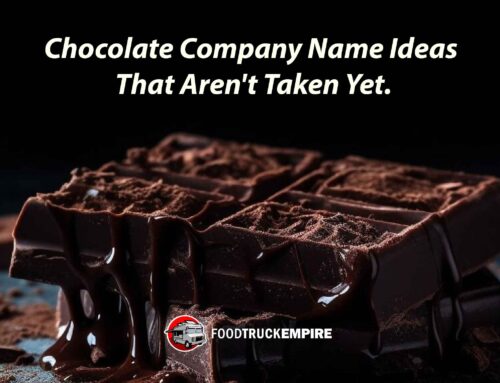The knife business isn’t just surviving… it’s flourishing. The blade-smithing industry is worth more than $12 billion and shows like Forged In Fire have put this industry in front of a national audience.
The knife industry in the United States has a total economic impact of $5.722 billion on the US economy. Because industry operators rely heavily on industrial activity and consumer spending, larger economic trends will continue to be crucial to the industry’s overall performance.
Kitchen knives, on the other hand, have grown in popularity as a result of reality shows like Top Chef, MasterChef, Hell’s Kitchen, Iron Chef, and Chopped, have inspired a new generation of home cooks. This subset is the kitchen knife market’s primary growth driver.
Want to learn more about the direction of the knife industry? I’ve compiled the most interesting data I could find about this industry below.

Knives with a wooden handle.
Knife Industry Statistics
Knives are used by 34 million hunters and anglers. (AKTI)
In the last two years, 73 percent of knife makers have raised their knife prices, and 71 percent of knife makers have indicated that their sales have increased this year compared to last year. (Red Label Abrasives)
Buying knives is an addictive habit, according to 87 percent of knife makers. Knife makers own 11-20 knives on average, according to 35 percent of them. 19% of knife producers have 40 or more knives, while 21% have 21-30 knives.
Stainless steel remains the most favored blade material among knife producers, with 53% choosing it. (Red Label Abrasives)
With 27% of the vote, high carbon steel was the second most favored material. (Red Label Abrasives)
Utility knives were found to be the most popular knives to make, with 50% of respondents saying they make them. (Red Label Abrasives)
Swords and hunting knives came in second with 49 percent of knife makers producing them. (Red Label Abrasives)
With 46 percent of the vote, tactical knives were the third most popular sort of knife to make.
Related Reading: 101 Data-Backed Employee Theft Statistics and Trends
The most popular handle material among knife producers is wood. Wood was chosen as the preferred handle material by 24 percent of knife producers.
Carbon fiber was the second most common material, with 20%, followed by titanium with 18%. A spear point was chosen by 34% of knife producers as their preferred blade shape.
The second most popular option was Bowie/clip point, which received 24% of the vote, followed by drop point, which received 12% of the vote.
40% of knife makers indicated they use a lanyard on their EDC sometimes, while 28% said they always do.
Only 9% of those polled said they use lanyards infrequently or never. Utility knives were found to be the most popular knives to make, with 50% of respondents saying they make them.
Knife Industry Market Size
The global market for kitchen knives was worth USD 1.17 billion in 2018, and it is expected to grow at an annual rate of 8.6% from 2019 to 2025. (Grand View Research)
Despite the COVID-19 situation, the global market for Commercial Kitchen Knives is expected to increase at a CAGR of 3.5 percent from 2020 to 2027, from an estimated US$495 million in 2020 to a revised US$629.1 million by 2027. (Business Wire)
Despite the global epidemic, the outlook for the knife-making sector is mostly good. The knife market is expected to rise by 78 percent in 2021, according to knife producers.
In the year 2020, the market for commercial kitchen knives in the United States is expected to be worth US$133.6 million. China, the world’s second-largest economy, is expected to reach a market size of US$132.3 million by 2027, with a compound annual growth rate of 6.4 percent from 2020 to 2027. (Business Wire)
In 2017, the tactical folding knives market was worth US$ 12.9 billion, and it is expected to increase at a CAGR of 2.7 percent from 2018 to 2026. (Globe Newswire)
The United States, Canada, Japan, China, and Europe are expected to fuel the global Bread Knives segment’s 2.3 percent CAGR. By the end of the analysis period, these regional markets, which had a combined market size of US$51.6 million in 2020, will have grown to US$60.6 million. (Business Wire)
During the period 2021-2025, the consumer kitchen knife market is expected to increase by USD 680.10 million, with a compound annual growth rate (CAGR) of 6.88 percent. (Technavio)
Chef’s Knives, one of the report’s sectors, is expected to grow at a rate of 4.1 percent per year and reach US$265.8 million by the conclusion of the analysis period. (Business Wire)
Due to the rising relevance of visual appeal in diverse cuisines, the market for kitchen knives will rise at a rate of 5.20 percent from 2020 to 2027. (Data Bridge)
The Meat Knives segment’s growth is updated to a revised 3.2 percent CAGR for the following seven years after an early review of the pandemic’s business effects and the resulting economic crisis. (Business Wire)
Related Reading: 101 Data-Backed Employee Motivation Statistics and Trends
During the projected period, APAC will account for 37% of the consumer kitchen knife market’s growth. In APAC, China and Japan are the most important markets for consumer kitchen knives. The market in APAC will increase at a quicker rate than the industry in other regions. (Technavio)
The Asia-Pacific market is expected to reach US$88 million by 2027, led by countries like Australia, India, and South Korea, while Latin America will grow at a 3.6 percent CAGR over the same period. (Business Wire)
Japan and Canada are two other notable geographic markets in the commercial knives sector, with growth forecasts of 1% and 2.6 percent, respectively, from 2020 to 2027. Germany is expected to expand at a CAGR of around 1.7 percent in Europe. (Business Wire)

A knife is a valuable tool during a survival situation.
American Knife Industry Statistics
In the United States, there are 4,704 direct employees working for 81 companies in the sporting knife and tool industry. (AKTI)
Men account for 22.97 percent of pocket knife owners in the United States, while women account for 9.72 percent. (Knife Rights)
Every hour of the day, 3.2 million police officers, EMTs, firefighters, and security guards carry important instruments.
The sporting knife and tool industry in the United States has a $5.722 billion economic impact. There are 2.2 million active and reserve military personnel who carry knives.
The United States sporting knife & tool industry has 23,520 ancillary support jobs in other industries and services. Knives and multi-tools are used by about 5.2 million construction workers.
The U.S. sporting knife & tool industry generated $953.7 million in gross revenue at the manufacturer/importer level. (AKTI)
Nearly a million adult volunteers in local councils around the United States and its territories assist the Boy Scouts of America, which has 2.4 million young members, in being prepared. (AKTI)
In 2014, almost half of all Americans (48.4%) engaged in at least one outdoor activity. This translates to 141.4 million persons who participate in activities in which blades are often carried and used. (AKTI)
The annual economic impact of hunters and anglers is $76 billion. (AKTI)
Related Reading: 59 Global Coffee Industry Statistics and Consumption Trends
Consumer spending on outdoor recreation, such as camping, backpacking, kayaking, climbing, and other activities, amounted to $646 billion. (AKTI)
In the United States, automatic knives are currently permitted in 34 states. The bulk of knife-related activities involve having one hand free to handle anything.
Knife users favor multi-tools with one or more knife blades, one-hand opening or aided opening, and automatics, as well as easy-to-open folding knives known as pocket knives.
Kitchen Knife Industry Statistics
Every year, 350,000 individuals are injured by kitchen knives. (BeaumontEH)
Chef’s knives are usually 8 to 10 inches long, but they can be as little as 6 inches or as long as 14 inches. (Escoffier)
In 2018, kitchen knives with stamped blades accounted for more than 75% of total revenue. (Grand View Research)
The boning knife may have been in the top four, but its importance as a need has waned in recent years. More and more individuals are purchasing meat pieces in the exact form they want to use. (Kitchen Kapers)
From 2019 to 2025, hand-forged manufacturing items are predicted to increase at the quickest rate, with a CAGR of 9.1%. (Grand View Research)
Fillet Knives are usually 7″ to 10″ in length. (Kitchen Kapers)
By 2025, Europe is predicted to have the highest share of the global kitchen knives market, while the Asia Pacific is expected to grow at the quickest rate during the forecast period. (Grand View Research)
From 2019 to 2025, the commercial application is predicted to grow at the fastest rate of 8.9%. (Grand View Research)
Many manufacturers, including Wusthof, Zwilling J.A. Henckels, Global, Victorinox, and others, use high-carbon stainless steel. (Kitchen Kapers)
In 2018, the convenience store category dominated the global market, with a market share of more than 58 percent. (Grand View Research)
Martensitic stainless steels, which are commonly used for both table knives and trade knives, contain between 12 and 18 percent chromium, which imparts corrosion resistance, and between 0.12 and 1 percent carbon, which allows for extensive heat hardening. (Britannica)
Friedr. Dick GmbH & Co., GLOBAL KNIVES, KAI USA LTD., KIYA & Co., Ltd., MAC Knife., MASAMOTO, Mercer Culinary, Messermeister, Victorinox, Wüsthof, and Zwilling J. A. Henckels are some of the top manufacturers in the market. For product development, the majority of these businesses invest in R&D. (Grand View Research)
In rural areas of India, Bangladesh, Myanmar, and other nations, hand-forged knives are quite popular. (Grand View Research)
Specialty knives, such as the Santoku, Sashimi Bocho, Nakiri Bocho, Usuba Bocho, and Deba Bocho, are used by consumers in China and Japan. (Grand View Research)

The Swiss Army Knife with USB.
Top Selling Knife Brands
The top knife brands can be a difficult term to define. It’s tough to compare pocket knife brands to chef knife brands side by side. I compiled some of the top brands across each knife category to highlight the industry leaders.
Victorinox. Without this world-famous pocket knife brand there would most likely be no Leatherman or other multi-tool maker. If you see the company’s trademark Swiss cross, you’re getting something truly special. Supreme engineering from the people who know multi-purpose knives. I owned one of these growing up and loved it.
Boker. Boker, widely known as “The Tree Brand” is one of a handful of import pocket knife producers that can compete with American makers. This company concentrates on using the best materials under the supervision of industry masters.
Wüsthof. The Wüsthof brand was founded in 1814 by a German family and has been producing high-quality knives and cutlery ever since. The brand is known all over the world for producing knives that are meticulously crafted to perform flawlessly and with the utmost ease. Wüsthof produces one-of-a-kind knives of the highest quality.
Elk Ridge. Elk Ridge knives are popular among hunters and outdoorsmen made with the highest standards by Master Cutlery. We adore their incredible value, durability, and dependability, which provide a lot of knife for the money.
Zwilling J.A. Henckels. J.A. Henckels is a world-class knife manufacturer offering the best value for money without sacrificing quality. Henckels knows what it takes to make high-quality knives, having been in the business for nearly a century.
Buck. Buck Knives has gone a long way since their first model, the 110 Folding Hunter was introduced in 1964 and is still a top seller. Buck knives are recognized for their durability, dependability, and aesthetic simplicity, making them an excellent choice for outdoorsmen and women.
A knife is a tool or weapon having a cutting edge or blade attached to a handle or hilt. Knives were one of humanity’s first tools, dating back at least 2.5 million years. At the time, the tool was used to hunt food or carving out prehistoric images on caves. Originally fashioned of wood, bone, and stone, they have evolved over time as metallurgy and manufacturing have improved.




